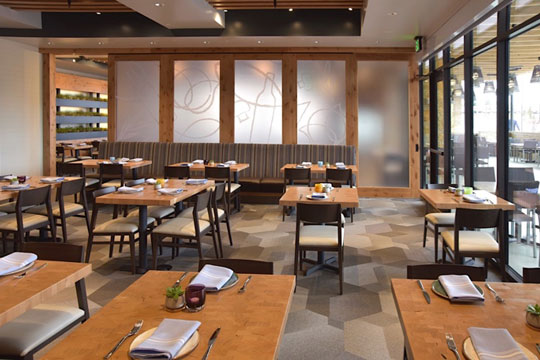Savor Genuine Eastern Cuisine With a Pan-Asian Twist for a Culinary Experience
Embarking on a culinary journey through authentic Eastern cuisine, boosted with a Pan-Asian twist, uses an unique chance to discover the abundant tapestry of tastes that define the region's varied cooking traditions. This experience welcomes you to relish the exquisite equilibrium of tastes-- wonderful, salty, spicy, and sour-- balanced by aromatic herbs and seasonings. Visualize the ingenious combination of Thai curry and ramen or the unexpected delight of sushi burritos. As you ponder these attracting recipes, consider the cultural narratives and historic influences that shape them, each bite supplying a story waiting to be discovered.

Exploring Pan-Asian Flavors
In the realm of global gastronomy, Pan-Asian food sticks out for its remarkable variety and the unified interaction of tastes from various Asian cultures. This culinary strategy commemorates the abundant customs and one-of-a-kind active ingredients located across the continent, developing a tapestry of tastes that is both intriguing and enjoyable. Key to Pan-Asian food is its capability to stabilize contrasting tastes-- pleasant, salty, spicy, and sour-- while highlighting the quality and top quality of each active ingredient.
From the umami-rich soy sauce of Japan to the fiery chili peppers of Thailand, Pan-Asian food supplies a comprehensive combination of flavors. These components are typically incorporated in inventive means, improving dishes with layers of intricacy. For example, making use of fragrant natural herbs such as lemongrass and cilantro, common in Vietnamese and Thai food, includes a revitalizing brightness to dishes, while the incorporation of coconut milk delivers a velvety, rich texture.
The emphasis on fresh fruit and vegetables and fragrant spices makes certain that each dish is not only a feast for the taste but also for the senses. Pan-Asian cuisine invites diners to embark on a cooking trip, exploring the large and differed landscapes of Asian gastronomy with every bite.
Combination Recipes to Attempt
While Pan-Asian food is commemorated for its conventional flavors, the modern-day culinary landscape is significantly embracing fusion recipes that mix these timeless elements with impacts from various other regions. This cutting-edge technique not just honors the abundant heritage of Asian culinary arts yet additionally introduces unique taste experiences that interest modern tastes.
A prime instance of such a blend dish is the Korean-Mexican taco, where seasoned bulgogi beef is covered in a warm tortilla, covered with kimchi and a spicy gochujang-infused salsa. This mix marries the vibrant, full-flavored flavors of Korea with the lively, fresh elements of Mexican food. Likewise, sushi burritos have actually acquired popularity, amalgamating the delicate artistry of Japanese sushi with the hearty, hand-held ease of a burrito, commonly featuring blend ingredients like tempura shrimp and avocado with a drizzle of wasabi mayo.
One more notable dish is Thai curry ramen, which infuses the velvety, aromatic spices of Thai curry right into the comforting brew of conventional Japanese ramen, producing an unified mix that entices the senses. These fusion recipes expand past mere novelty; they stand for a culinary discussion between societies, encouraging exploration and advancement on the planet of Pan-Asian cuisine.
Necessary Ingredients and Flavors
To truly appreciate Pan-Asian food, one need to recognize the necessary ingredients and seasonings that create its structure. This varied culinary style draws from an abundant tapestry of Asian traditions, utilizing an unified mix of flavors and appearances.
Aromatic elements are critical, with garlic, ginger, and lemongrass you can try this out being ubiquitous throughout various Pan-Asian recipes. These ingredients offer a fragrant base that improves the intricacy of tastes. Flavors such as celebrity anise, cardamom, and cinnamon present warmth and personality, resembling impacts from areas like China and India.

Cooking Strategies and Tips
Understanding the art of Pan-Asian food calls for experience with its distinctive food preparation strategies, each contributing to the vivid tapestry of flavors this cooking custom is commemorated for. Central to these approaches is the stir-fry, a rapid cooking strategy that maintains the nutritional honesty and vivid shades of active ingredients. Using a frying pan, the stir-fry approach enables also warm circulation, necessary for achieving the particular appearance and taste balance of Pan-Asian dishes.
One more essential method is steaming, especially widespread in Chinese cuisine. This gentle method maintains the all-natural tastes and nutrients of components, making it ideal for seafood and veggies. Dumplings, a precious staple, frequently take advantage of steaming, resulting here in soft, succulent structures.
Barbecuing, also indispensable, presents great smoky midsts to dishes such as Korean bulgogi or Japanese yakitori (asian fusion restaurant). This strategy frequently includes marinating active ingredients, allowing tastes to penetrate deeply before food preparation over an open fire or warmer
Finally, understanding the art of stabilizing flavors-- wonderful, sour, salty, bitter, and umami-- is important. Properly layering these components can raise a dish from ordinary to amazing, supplying a complicated and satisfying cooking experience that personifies the essence of Pan-Asian cuisine.
Eating Experiences Worldwide
Across the globe, Pan-Asian cuisine provides an unrivaled eating experience, celebrated for its rich tapestry of tastes and lively discussions. This cooking sensation has transcended cultural boundaries, recording the hearts and palates of food lovers worldwide. In multicultural cities like New York, London, and Sydney, Pan-Asian dining establishments offer as melting pots where cooking traditions from Thailand, Japan, China, and breakfast food near me beyond assemble, offering restaurants with a diverse mix of meals that highlight the area's diversity.
The global allure of Pan-Asian cuisine lies in its capacity to use both authenticity and advancement. Chefs skillfully wed typical ingredients such as lemongrass, soy sauce, and miso with modern techniques, resulting in recipes that are both refreshingly brand-new and familiar. This blend allows diners to start a culinary trip that appreciates heritage while welcoming modernity.
Furthermore, eating experiences are boosted through attentively made environments that show the values of Pan-Asian looks. From minimalist Japanese-inspired insides to lively Thai-themed spaces, each restaurant uses an one-of-a-kind ambiance that complements the cooking offerings. As a result, customers are not simply eating a dish however partaking in a cultural experience, making Pan-Asian dining a really global phenomenon.
Verdict
The expedition of Pan-Asian food supplies a profound understanding of the elaborate interaction of tastes and culinary practices across Asia. By embracing blend dishes such as Thai curry ramen and sushi burritos, the cooking journey not only highlights the versatility of conventional components yet additionally showcases ingenious contemporary methods. This gastronomic journey, enhanced by vital flavors and cooking approaches, gives an unique opportunity to appreciate the social variety and cooking artistry that define Pan-Asian food on an international scale.
Getting started on a culinary journey with authentic Oriental food, boosted with a Pan-Asian twist, provides an one-of-a-kind opportunity to explore the abundant tapestry of tastes that specify the region's varied cooking practices.In the world of global gastronomy, Pan-Asian cuisine stands out for its exceptional variety and the harmonious interplay of flavors from various Asian cultures. Secret to Pan-Asian cuisine is its capability to stabilize contrasting tastes-- pleasant, salty, spicy, and sour-- while highlighting the freshness and top quality of each ingredient.
